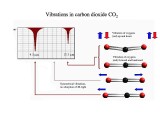 Only molecules that can change their dipole moment upon oscillating can absorb the wavelengths of infrared light. This condition is met with molecules that are composed by two different or at least three atoms. Two atom gases such as oxygen O2 or nitrogen N2, the major components of our atmosphere, can only oscillate symmetrically, which does not change the dipole moment: Consequently, these gases are not green house gases, they do not contribute to the global warming on earth. Carbon dioxide CO2, consisting of three atoms, and can oscillate in a symmetric, but also in an unsymmetrical way (Figure below, click for enlargement). Infrared light excites the latter and is therefore absorbed. However, it is not the whole range of wavelengths (1 to 40 µm) that is absorbed, but only a small part that is different for every green house gas. Carbon dioxide is absorbed in two distinctive areas in the infrared area, i.e. at 4.3 and 15.3 µm.
Only molecules that can change their dipole moment upon oscillating can absorb the wavelengths of infrared light. This condition is met with molecules that are composed by two different or at least three atoms. Two atom gases such as oxygen O2 or nitrogen N2, the major components of our atmosphere, can only oscillate symmetrically, which does not change the dipole moment: Consequently, these gases are not green house gases, they do not contribute to the global warming on earth. Carbon dioxide CO2, consisting of three atoms, and can oscillate in a symmetric, but also in an unsymmetrical way (Figure below, click for enlargement). Infrared light excites the latter and is therefore absorbed. However, it is not the whole range of wavelengths (1 to 40 µm) that is absorbed, but only a small part that is different for every green house gas. Carbon dioxide is absorbed in two distinctive areas in the infrared area, i.e. at 4.3 and 15.3 µm.
 Does the carbon dioxide in our atmosphere contribute to the increase of temperature on earth by absorbing infrared light at 4.3 and 15.3 µm? Absolutely! Without the green house effect the temperature on earth would be 33°C lower, and life on earth - at least the way we know it - would not be possible. The biggest contribution to the green house effect, i.e. 66% or 22°C, has water vapor, which is consequently the most effective of all green house gases. The natural occurring carbon dioxide in our atmosphere adds another 5°C or 15% to the overall effect.
Does the carbon dioxide in our atmosphere contribute to the increase of temperature on earth by absorbing infrared light at 4.3 and 15.3 µm? Absolutely! Without the green house effect the temperature on earth would be 33°C lower, and life on earth - at least the way we know it - would not be possible. The biggest contribution to the green house effect, i.e. 66% or 22°C, has water vapor, which is consequently the most effective of all green house gases. The natural occurring carbon dioxide in our atmosphere adds another 5°C or 15% to the overall effect.
The natural percentage of carbon dioxide in our atmosphere is only 0.03%, which sounds little but computes to a total amount of 2700 billion tons - a vast amount that remains approximately constant due to the natural carbon cycle (emission of carbon dioxide by living beings, absorption by plants). Due to burning of fossil fuels and the destruction of forests about 25 billion tons or 1% is added each year by human civilization.
The effective raise in concentration in the atmosphere is however only 0.3%, since especially the oceans provide an efficient storage for carbon dioxide. This increase might seem small, but during the last century a significant overall increase from approximately 0.028% (280 pm, ppm = parts per million) to 0.036% (360 pm) has been the accumulated result.